A howling good review of Nosler’s blazingly-fast 27 Nosler cartridge.
By Dan Larsson
I wiped a foot of snow off the log to see down the flat ridge covered in charcoal dead trees. Dropping my pack in the snow, I sat on it and pulled out my elk/do-all animal call. Turning the scope down to 3x, I knew that it would be close shooting if this worked. I checked and rechecked that my chamber was occupied with a 27 Nosler cartridge and that the gun's safety was off. Then I hit the call. I leaned toward half snowshoe hare and half muley fawn and blew like crazy. I could hardly feel my lips, it had to be around zero degrees, and I lost a lot of my breath around the call instead of through it as my lips had no strength. I prayed the reed wouldn't freeze up in the call, and my eyes swept back and forth as if I was at war and my life depended on seeing my quarry before it saw me. It worked.
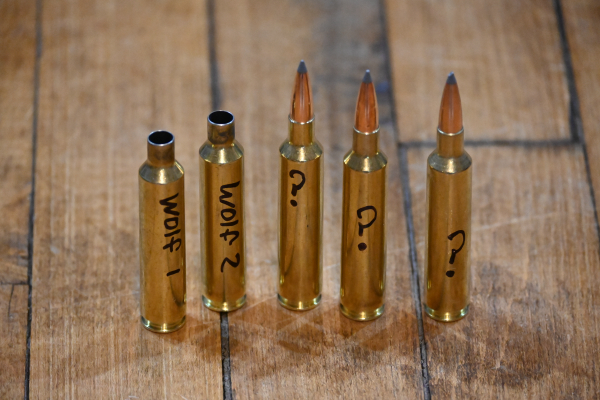
The 27 Nosler chambered in Nosler’s M48 Long Range Carbon Rifle was more than enough gun for two wolves in western Montana. What else will Dan Larsson take with his 27 Nolser? Stay tuned to The Hunting Wire to find out.
All but one opening day of the big game season over the past seven or eight years have been spent with my buddy Jared. He is a great long-range shooter and hunter. We've learned that some of the only real BIG bucks in Montana's general hunting areas live in the kind of mountains that no sane hunter would climb. In 2014 we hiked 3+ miles into the snow the day before the season, and due to our logic of taking less weight, we didn't take pads to go under our sleeping bags. With nothing more than a tarp between our bags and the snow, we slept back to back (in our bags), shivering like crazy. Well, this year, we didn't want to snuggle and opted to sleep in the back of his truck with more than one sleeping pad under each of us. A big storm rolled in, and the road on the way to the mountain was covered with people who slid off or lost traction going uphill. We managed to make it to our pull out and parked for the night. The truck bed idea wasn't half bad, and we got a decent night's sleep despite being in the single digits of our country's accepted temperature-evaluation-system (Fahrenheit).
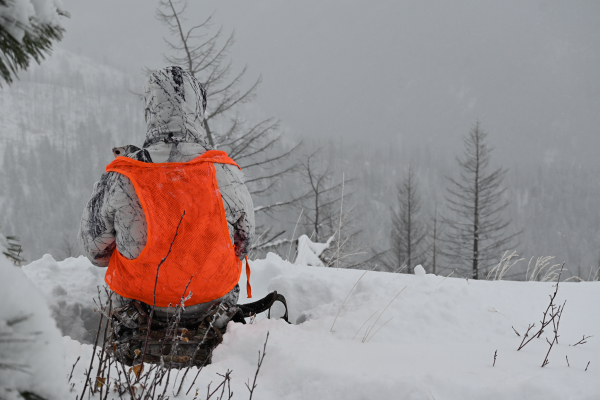
Western Montana and wolves mean harsh conditions and snow. The predators are tough, the hunting is tough, and if you want to be successful you better be tougher and accurate when it's time to shoot.
Before daylight, our alarms went off, and I jumped out of my bag and got dressed. Ha! Let's rewrite that. Before daybreak, our alarms went off, and I could not get myself out of my bag. It was so cold. I pulled my clothes inside my sleeping bag and screamed a little as the chilled fabric met my skin. I gave it a minute to start warming up and did a cramped version of Pilates as I wrestled my three layers, top, and bottom, onto my shivering self. We exited the back of the truck, grabbed our guns and packs, and then headed up the ridge that wound its way up on top of the mountain. Boy, was it cold! However, we were headed up in a foot of snow, at such an incline, that we were plenty warm in a couple of hundred yards. It was growing light, and we spotted a few whitetail does coming around the ridge. No bucks. We hoped that the early cold weather would throw the deer into an early rut like it did last year. We kept climbing and hit muley tracks at about 5,000 feet. We bumped a few does just as we got on top of the ridge, and then we kept working our way up.
We found another mile along, where many sizeable footed deer crossed a swale in the top of the hill. Just beyond this was a reasonably open ridgetop with views of the surrounding side ridges. This area had burned in the last few years and had timber strips and lots of dead black trees. Jared has always been a better game spotter than I am. I think he's just a bit more excited and hyper, and so he gets his glass on them first. Whichever the case, it worked for me on our hunt in 2014. I had scouted early and found my buck, and he glassed it up for me on opening morning after our coldest night ever, as referenced above. We still joke about that to this day.
The wind was blowing so strong, and the snow was cold enough that it would just blow wherever the wind went. I'm convinced that if we had been in Eastern Montana, the snow would have ended up in the Dakotas. All-day long, we would flip-flop back-and-forth on that open hilltop, glassing like madmen. I had a full fleece facemask, and my binos and glasses would fog up every time I tried to use them. You do the best you can with it, and we spotted 30-40 some deer that day. We saw three nice bucks, and then Jared spotted a nice buck. As best as we could tell, he would probably have gone right about 170". This wasn't big enough to haul out of this area on opening day, though, so we kept looking and kept finding more deer. It's an area where the deer come to rut after they are pushed out of the big mountains where a lot of snow necessitates their move to survive at a lower elevation.
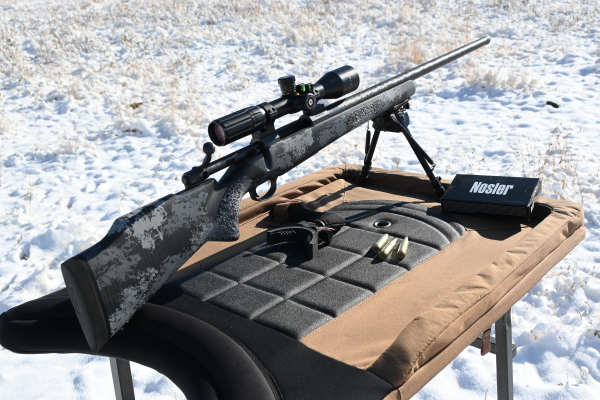
The ultra-modern rifle and cartridge combination from Nosler earned its keep in the tough western Montana
At one point, I tried to use my camping stove for cooking a hot meal for us. It was so cold that the butane wouldn't flow fast enough to boil water. So, we made a fire and boiled water in a tin cup for our dehydrated meals. I always carry a cup for this purpose and am glad I do! Last season we hunted a different mountain where Jared killed a 190" buck. The problem was that there was no water for us to get up on that ridge, so we had to melt snow for water. This is a miserable way to get water, by the way.
Remember how I mentioned that the snow was blowing like crazy. It blew so hard and so much that it packed around the bolt and action of my rifle. I went to check it, and it would not budge. So, I worked and worked with it and finally got some movement. Back and forth until it finally came all the way open, and I removed the bolt. There was snow in the magazine, snow in the back of the action, and snow every other little crevasse you could imagine. I spent some time trying to remove it while trying not to warm the snow so much that it would melt and freeze in action. I had never seen anything like it. With it clear, I tried to hold the action at an angle that kept the snow from repeating this problem. I even checked that the firing pin would still strike with sufficient force to detonate a primer on an empty chamber. I have heard horror stories and didn't want to urinate on my bolt for one hopeful shot at a critter. It was perfectly lubed (which means a minimal amount of non-coagulating oil or grease) and would fire if I needed it. Boy howdy, would I need it to fire in an hour or so later. Twice.
I assumed no wolves in the area because we hadn't seen any wolf sign, and we saw a lot of that many deer. Just as the sun was starting to set on a ridge where we had been watching the muleys filter into the basin all day, a chorus of hopefully mournful wolf howls began. After two decades of the wolves decimating our deer and elk, our herds are beginning to learn how to live with them. We will never have the number of deer and elk we used to, and it is a challenge many times to find a legal game animal in Western Montana. However, I am encouraged to see this many deer near a pack of wolves. Granted, they were migrating into this area from the larger surrounding area. If we see 6-12 muleys, most hunts feel like we've had a productive hunt.
I was excited and projected that we should move closer and call them in. We discussed how and then headed around the ridge.
I can't tell you how glad I was to know that my bolt was working again. This year I'm packing a Nosler M48 in the Long-Range Carbon Rifle. As soon as I saw this rifle, I fell in love. And then I got to hold it, and I became a doomed man. Like picking the wife you want to spend the rest of your life with, a man needs to carefully pick his rifle. My advice? Go for the best quality you can and never settle for less in these two departments! I found this kind of quality in this rifle (not that it compares to my wife, mind you). Nosler's new 27 cartridge is fantastic. It's similar to a 7mm Remington Magnum in ballistics. Yet, it gives you better sectional density with comparable bullets and a better ballistic coefficient (slides through the air easier due to a smaller diameter and maintains its speed better). After breaking the barrel in, it took less than ten rounds to sight it in and work my way out on my steel target range 1050 yards. I didn't want a heavy scope on such a light gun, so I ordered a 3-9x SWFA that weighs just over a pound. I use SWFA scopes because I can sight them in with a few clicks, dial out to shoot at a mile, and then back to zero at 100 yards, and they are always right on. You can't beat the quality of these scopes for their price. This combination of rifle and scope is a terrific pairing!!! With a bipod on, it still feels lighter than a usual rifle combo.
As we reached the spot where the wolves met the 27, Jared stayed to my left where he could watch a hillside, we expected them to come down, and I slid forward to my log. After five or so minutes (plus or minus as who knows how long it takes when you are excited), I saw the first wolf come into view. My hit list includes a white and a black wolf. This one was gray and was still one of the most beautiful creatures I've laid my crosshairs on. I wasn't going to pass him up!
I tracked the wolf in my scope, and it had an uncanny way of staying behind the dead trees as it came in. Then it split off to my left and out of sight over the side of the hill towards Jared. I hadn't seen the one behind it that kept coming as I called. He would hold up if I stopped calling, so I kept squealing and squawking away until he cleared a tree at much closer than I would have ever expected. Jared later paced it off and said it was 18 yards from my log when he came into view and stopped. I shot him facing straight on, and he dropped into the snow and almost disappeared. I've hunted enough coyotes to know that you don't jump up and congratulate yourself. I hit the call just as I had been, and a couple of minutes later, a white wolf came from the left where the first one had gone. I followed it with my scope, but it never stopped. It just kept going to the right and disappeared behind the ridge I was on. Now I was calling and doing a lot of glancing over my shoulder. I just knew that wolf was circling and going to come over the hill just behind me. Even so, I kept calling and kept my head on a swivel. About a minute after that, another gray-colored wolf came and followed the same path the white one had. I couldn't make the same mistake again, so I barked when it hit a clearing in the trees. It stopped right behind a tree. When it began moving, I barked again. It stopped, and I tripped the trigger. It, too, dropped in its tracks. I called some more and then howled some. No more were coming in, and it was getting dark, so I stopped calling and looked behind me.
Jared was coming through the snow and was hopeful that I had better than fleeting shots and hadn't missed. He was quite concerned that I had missed. Hahaha. He should know me better than that. That first wolf that went left just before I shot went bounding past him but disappeared before he could get a shot. When he saw the big guy laying just past me, and I told him I had another down, he came unglued! Approaching the second wolf, I finished it off with my Glock.
It was cold, and the last light was fading quickly, so we took some quick pictures and got to skinning. You don't haul a whole wolf three miles out of the high country in that kind of snow. Plus, I could hardly pick the big guy up. He was super heavy, and I'm sure he tipped the scales around 100 pounds. We skinned for about an hour, careful not to put extra holes in the hides. While we did, we could hear the rest of the pack begin to howl from different spots at the back of the basin. They found each other and howled at us the whole time we were skinning.
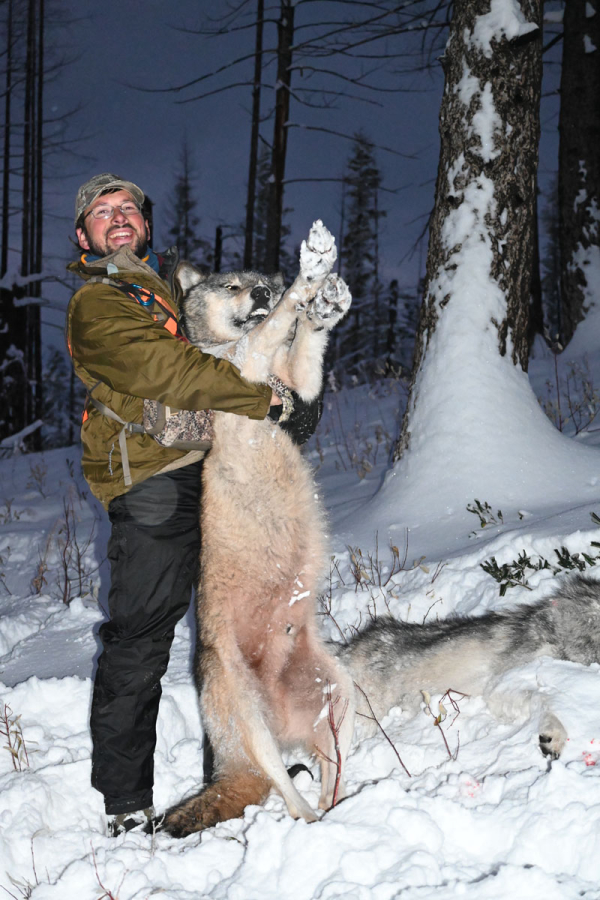
The author poses with one of the wolves he shot with the Nosler M48 Long Range Carbon Rifle chambered in 27 Nosler.
I researched how many ungulates (deer, elk, moose, sheep, antelope and goats) each wolf will eat per year. The biologist was discussing it estimated 20-25 ungulates per wolf every year. By this estimation, I saved 40-50 animals this year and 400-500 over the next ten years! I always carry more than one wolf tag and am glad I do! This wolf hunt will always be one of my most memorable hunts. How Epic! My only regret is that Jared didn't get one also. He will because he's a fantastic hunter. It's only a matter of time until he saves a bunch of deer and elk from the teeth of a wolf. Since this hunt, I've taken some first-time hunters searching for deer in two different spots. We heard wolves howling in both of these other areas.
Always carry a license and pray to get lucky!
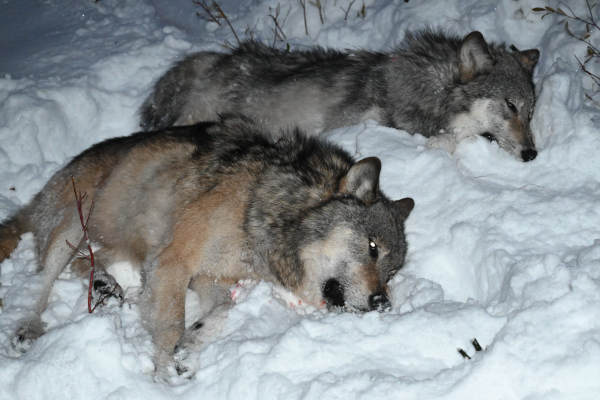
Hunting wolves pits predator against predator on the wolf’s turf.